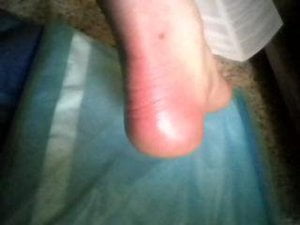“Erythro–what?”
Strangers will often say this to me when they look at my bright red, painful-looking feet and ask what is wrong. I say, “It’s erythromelalgia,” evoking their incredulous response.
Erythromelalgia is a disease whose defining symptom is burning red extremities due to blood engorgement. The cause of the engorgement can be genetic or secondary to other causes, but in either case dysfunction of the thermo-regulatory system is involved.
For the last four years my feet, which used to be very cold especially at night, have gotten gradually hotter, starting in the toes and spreading up to the ankle. Now when I go to bed in wintertime, instead of piling four layers of blankets with slippers on my feet, I stay barefooted with no covers on them at all. Go figure!
Dr. Jay Cohen, MD, an EM sufferer and board member of The Erythromelalgia Association, writes: “Erythromelalgia is a rare condition that has remained an enigma diagnostically and therapeutically for decades. It has been assumed that erythromelalgia, which is characterized by hot, red, intensely painful feet or hands, may be the opposite of Raynaud’s phenomenon. However, new research suggests that these two disorders are more similar than dissimilar. Erythromelalgia usually follows a chronic, sometimes progressive and disabling course. New evidence suggests that this may not be a disease entity at all, but a syndrome of dysfunctional vascular dynamics; recent studies demonstrate that this dysfunction is reversible in some patients.”1
Because it is so rare and poorly understood (1.3 in 100,000 Americans are thought to have it), very few doctors know much about EM, and patients often end up self-diagnosing.
Such was my case after visiting a podiatrist who ran a battery of tests and came up with nothing. The heat and swelling in my toes were causing fungal overgrowth (athlete’s foot), with the usual skin fissures leading to more swelling and pain. Against all written advice, I resorted to using ice directly on my feet. I thought I didn’t have to worry about frostbite, but I was wrong. Soon I became utterly dependent on direct ice 24/7 while the swelling and heat only worsened. My naturopath finally convinced me to get off the ice, and after three days of hell, two trips to ER and lots of narcotics the swelling somewhat stabilized. Now I rely on cold gel packs I made myself out of silica crystals and water in gallon-size zipper-locked plastic bags. I store a half-dozen of them in the refrigerator, which is cold enough to provide relief without worsening my symptoms. It keeps the athlete’s foot at bay and I haven’t had skin fissures but once during the hot summer months. At bedtime I take 3-4 packs to bed to get through the night. Fans are helpful, and cold water soaks can provide great relief. (Tip: to avoid skin breakdown and necrosis, add mineral salts to the cold water when soaking.) Still, my social life is considerably limited due to the need to keep my feet cool and out of the sun.
How did this happen to me? There are many scenarios possible. Dr. Cohen has been helpful with his online articles and telephone consultations in troubleshooting my particular problem. So far I am left with the conclusion that it is triggered by my fibromyalgia, which I have had for 20 years. I have ongoing muscle spasms on a daily basis, which have spread into the involuntary muscles and internal organs, and it stands to reason the blood vessels are now affected. WIth the periodic blood constriction, the autonomic nervous system is getting mixed messages, causing it to over-compensate for what it assumes is a shortage of blood flow to my feet. The result: blood engorgement, visible redness resembling sunburn, heat, and edema.
Another identified cause of EM is mercury poisoning. I have been diagnosed with lead poisoning and am pursuing chelation treatments on the outside chance that it is somehow related. If you have burning extremities, read what you can on the internet, as more information is being discovered all the time. The Erythromelalgia Association (TEA) is a patient support group with members across the country. Yahoo Groups has an EM patient group with international members, and a Facebook page exists for EM patients as well.
Though EM is supposedly rare, I have personally met a half dozen people in the last year with similar problems. As there can be many causes, be sure and get help from an understanding physician.
Source
1 Erythromelalgia: new theories and new therapies. Cohen JS, Departments of Psychiatry, University of California, San Diego, USA. http://www.ncbi.nlm.nih.gov/pubmed/11050591 9/10/12






